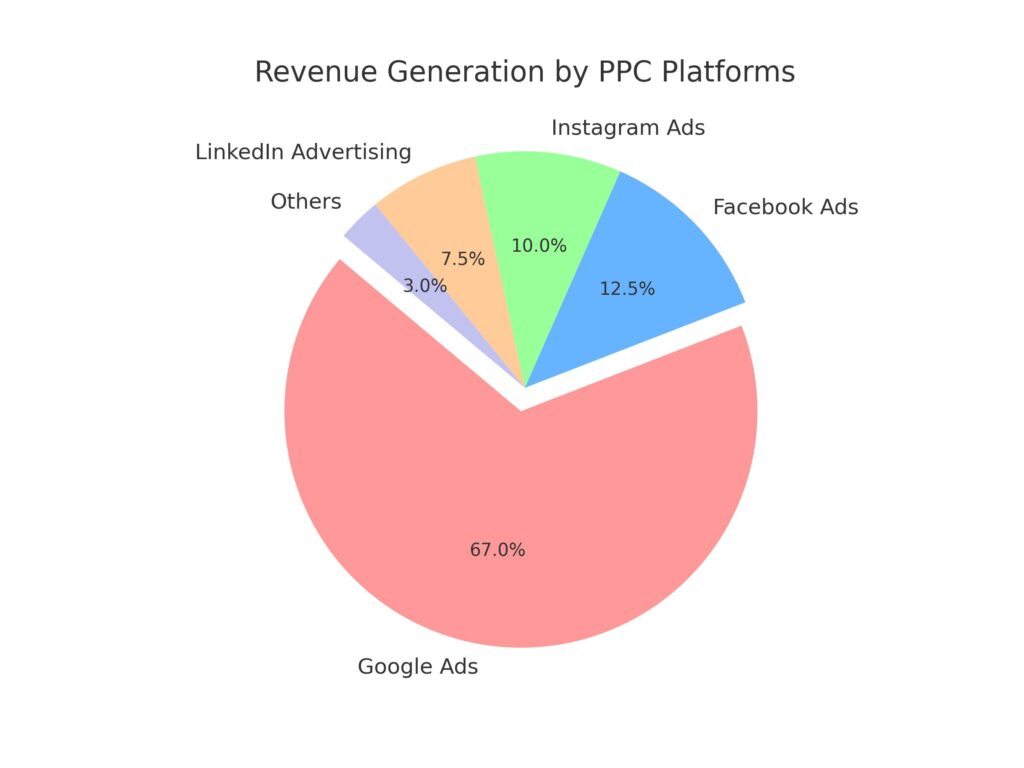Are you trying to boost your online presence but getting tangled in the web of digital marketing terms?
Google, a giant in the field, generates over $134 billion from PPC marketing.
This article breaks down the differences between PPC vs. CPC, making it easier for you to understand and apply these concepts. Keep reading for insights that will light your way.
Key Takeaways
- PPC stands for Pay-Per-Click where advertisers pay each time one of their ads is clicked. It’s a great way to get traffic quickly.
- CPC, or Cost-Per-Click, measures how much you pay when someone clicks on your ad in a PPC campaign. Keeping this cost low while getting clicks helps save money and make campaigns more effective.
- Google Ads is a top platform for PPC marketing, generating significant revenue. Other platforms include Facebook Ads, Instagram, and LinkedIn Advertising, each offering unique benefits depending on the target audience.
- Factors like Quality Score and keyword competitiveness affect both PPC and CPC. By choosing the right keywords and improving ad quality, you can lower costs.
- Using both PPC and CPC together lets marketers manage budgets better while reaching their advertising goals by paying attention to how much they’re spending per click and adjusting strategies to optimize ad performance.

- Importance PPC and CPC in digital marketing
- Understanding PPC (Pay Per Click) Marketing
- Understanding CPC (Cost Per Click) Marketing
- Key Differences Between PPC and CPC
- Benefits of Using Both PPC and CPC in Digital Marketing
- How to Calculate and Measure CPC and PPC Performance
- Conclusion
- Frequently Asked Questions (FAQs)
Importance PPC and CPC in digital marketing
Understanding PPC and CPC is crucial for digital marketers and advertisers aiming to optimize online advertising efforts. PPC, or pay-per-click, is a model where marketers pay a fee each time their ad is clicked.
This approach helps drive traffic and increase sales conversions effectively. On the other hand, CPC, or cost-per-click, measures how much that click costs. It’s vital in managing campaign budgets and ensuring you’re not overpaying for ad clicks.
Grasping these concepts enables marketers to craft strategies that reach a vast audience while targeting specific customer demographics—key factors like keyword competitiveness, search volume, and click-through rate significantly impact your advertisement’s CPC.
Mastering both PPC and CPC paves the way for lowering advertising costs while maintaining high-performance levels of campaigns across platforms such as Google Ads.
Brief definition of PPC and CPC
PPC stands for Pay-Per-Click, a model of online advertising where marketers pay a fee each time one of their ads is clicked. Essentially, it’s a way to buy visits to your site, rather than attempting to earn those visits organically.
This approach helps businesses drive traffic and increase sales conversions through various PPC platforms like Google Ads or social media channels.
CPC means Cost-Per-Click, representing the amount an advertiser pays every time someone clicks on their ad in a PPC campaign. It acts as a performance metric that advertisers use to measure the effectiveness and cost-efficiency of their digital marketing campaigns.
Monitoring CPC is crucial for optimizing advertising spend and achieving better return on investment within the competitive landscape of online marketing.
Understanding PPC (Pay Per Click) Marketing
PPC marketing lets you pay only when someone clicks on your ad, making it a smart option for many businesses – read on to discover how this could work for you.
Explanation of how PPC works
PPC, or pay-per-click, is a model of online advertising where marketers pay a fee each time someone clicks on their ads. This approach drives traffic from search engines and can increase sales conversions significantly.
Marketers bid for ad placement in a search engine’s sponsored links when someone searches for a keyword related to their business offering. For example, if we bid on the keyword “PPC software,” our ad might show up in the top spot on Google’s results page.
The success of PPC campaigns hinges on several factors like maximum CPC (cost per click) and Quality Score. A higher Quality Score means that your PPC ad is relevant and useful to viewers, which can reduce your cost per click.
Effective use of content plays a crucial role here—high-quality content tied to specific customer demographics can boost ad performance dramatically, reaching a vast audience and potentially delivering high return on investment.
Benefits of PPC advertising
PPC advertising stands as a powerful tool for digital marketers and advertisers aiming to boost online presence. It allows for precise targeting, immediate traffic, and potential high returns on investment. Here’s how PPC advertising benefits your marketing strategy:
- Drives Immediate Traffic: Launching a PPC campaign can quickly draw visitors to your site or landing page. Unlike organic growth tactics, which take time, ads start showing up in search results as soon as the campaign goes live.
- Targets Specific Audiences: Advertisers can set their campaigns to only show ads to their ideal customers. This means you can target people based on location, interests, and even the type of device they’re using.
- Enhances Brand Visibility: Even when users don’t click on your ad, they see your brand name and what you offer. This increases brand awareness among your target audience.
- Gives Control Over Costs: You pay for each click, which means you can manage your budget effectively. Setting maximum bids for each keyword helps control spending without sacrificing visibility.
- Provides Valuable Data: Through tracking clicks and conversions, you gain insights into customer behavior. This data helps refine marketing strategies and improve future campaigns.
- High Potential ROI: By reaching the right people at the right time, PPC advertising often leads to a high return on investment. Targeted ads mean more conversions, which translates into more sales for every dollar spent.
- Speeds Up Sales Conversions: Users clicking on PPC ads are usually ready to make a purchase or sign up for a service – leading to quicker sales conversions compared to some other marketing methods.
- Flexible Marketing Option: Campaigns can be adjusted or paused anytime based on performance or budget changes. This flexibility is crucial in responding quickly to market trends or company needs.
- Works Well With Other Digital Strategies: PPC complements SEO efforts by covering both paid and organic search strategies—helping businesses dominate both sides of search engine results pages.
- Reaches Customers Through Multiple Platforms: From Google Ads to social media platforms like Facebook and Instagram—PPC allows businesses to utilize various channels to reach their audience where they spend most of their time online.
- Lowers Cost-Per-Click Over Time: As more clicks come in indicating success, the overall cost-per-click (CPC) can decrease, making it a cost-effective part of digital marketing efforts over time.
- Improves Landing Pages And Quality Content: Successful PPC requires well-crafted landing pages and high-quality content—encouraging continual improvement of website elements that benefit overall digital presence.

Examples of PPC platforms
Exploring the top PPC platforms can unlock new opportunities for digital marketers and advertisers. Each platform offers unique features that cater to different advertising goals.
- Google Ads – Leading the charge in PPC marketing, Google Ads is a powerhouse, generating over $134 billion in ad revenue. Marketers can display their ads across Google’s extensive network, including search results, websites, and YouTube videos. This platform excels with its broad reach and diverse ad formats like Search Ads, Video Ads, and Shopping Ads.
- Facebook Ads – A vital tool for targeting specific demographics, Facebook Ads allows advertisers to reach users based on interests, behaviors, and detailed demographics. With billions of active users, this platform is perfect for campaigns aimed at increasing brand awareness and engagement.
- Bing Ads – Now rebranded as Microsoft Advertising, Bing Ads offers access to a significant portion of the search market not using Google. It provides similar services to Google Ads but with generally lower cost per click (CPC), making it an attractive option for those looking to extend their advertising dollars further.
- LinkedIn Advertising – Ideal for B2B marketing efforts, LinkedIn Advertising helps target professionals by job title, industry, or company size. Whether it’s promoting content or driving leads through sponsored updates or InMail messages, LinkedIn is unmatched in reaching a professional audience.
- Twitter Ads – Excellent for engaging in real-time with users around current events or trends. Twitter ads offer unique targeting options like hashtags or keywords mentioned in tweets allowing brands to insert themselves into ongoing conversations relevant to their business.
- Instagram Ads – As part of Facebook’s advertising system, Instagram offers visually focused ad formats including stories ads, photo ads, video ads but with a stronger emphasis on aesthetics and storytelling. It’s great for brands with high-quality visuals looking to captivate a younger demographic.
- Amazon Advertising – For e-commerce focused campaigns, Amazon Advertising lets sellers place product listings directly in front of consumers ready to buy. Using keyword-targeted ads appears either within search results or on product pages can boost visibility among millions of shoppers searching on Amazon.
Each PPC platform serves different needs depending on your campaign goals and target audience—leveraging them effectively requires understanding their distinct advantages.
Understanding CPC (Cost Per Click) Marketing

Cost Per Click (CPC) Marketing puts a price tag on each click your ad receives. It’s all about figuring out how much you’re willing to pay for someone to click on your ad.
CPC as a performance metric
CPC stands as a crucial metric in PPC campaigns, measuring the cost advertisers pay for each click on their ad. This financial indicator helps businesses gauge how much they’re investing to attract potential customers through clicks.
The average CPC is found by dividing the total campaign cost by the number of clicks received. This calculation reveals the efficiency and cost-effectiveness of ad campaigns on platforms like Google Ads and other digital advertising channels.
Several factors impact CPC rates, including keyword competitiveness, search volume, ad rank, and click-through rate (CTR). Advertisers aim for a lower CPC to stretch their advertising budgets further while still capturing high-quality leads.
By closely monitoring CPC trends and adjusting bids accordingly, marketers can optimize their PPC strategies for better ROI. Keeping an eye on these metrics allows for strategic adjustments that enhance campaign performance over time.
Factors that influence CPC
Determining the cost-per-click (CPC) is crucial for setting up successful advertising campaigns. Several factors come into play when figuring out how much each click will cost you. Let’s explore these key elements:
- Quality Score – Google Ads uses Quality Score as a measure of how relevant and useful your ad is to the user, based on your ad’s click-through rate, the relevance of each keyword to its ad group, landing page quality, and the user’s experience. Higher scores can lead to lower CPCs because Google rewards well-crafted ads.
- Ad Relevance – Ads that closely match a user’s search intent are more likely to get clicks, influencing CPC. Advertisers need to make their ads as relevant as possible to the user’s search query.
- Landing Page Experience – A smooth and relevant landing page not only contributes to a better Quality Score but also persuades users that clicking was worth it. This helps maintain or even reduce your CPC.
- Bid Amount – Your maximum bid amount significantly influences your CPC. The higher you’re willing to pay for a click, the more competitive you are in auctions for ad placement. But be careful; balancing bid amount with budget constraints is key.
- Competition – Highly competitive keywords drive up the CPC because more advertisers are bidding on them. Researching less competitive keywords with decent traffic can help manage costs effectively.
- Season and Time of Day – During peak shopping seasons or times of day when internet traffic spikes, CPC can increase due to heightened competition among advertisers for users’ attention.
- Device Targeting – Clicks from different devices (mobile vs desktop) can have varying costs associated with them, influenced by user behavior and conversion rates on these devices.
- Geographical Location – Targeting ads to specific locations can affect your CPC since some regions may have higher competition or differently valued markets.
- Ad Format – Some ad formats may incur higher CPCs due to their prominent placement or enhanced features that attract more clicks or engagement from users.
Each of these factors plays a role in calculating and managing your advertising campaign’s overall cost-per-click (CPC). By understanding and optimizing these areas, digital marketers and advertisers can better control their budgets while striving for high-performance outcomes in their PPC campaigns.
Importance of monitoring CPC
Keeping an eye on CPC, or cost per click, is essential for digital marketers and advertisers aiming to maximize their return on investment in PPC campaigns. This indicator not only reveals the financial efficiency of your ads but also sheds light on the quality of traffic coming to your website.
A lower CPC means you’re driving more visitors without burning through your budget too quickly.
Analyzing CPC allows you to fine-tune your strategies, ensuring that every dollar spent pushes you closer to your marketing goals. By actively monitoring this metric, marketers can identify which keywords and ad placements offer the best value, enabling them to adjust bids and optimize ad performance continuously.
This vigilance leads to smarter spending and improved campaign results over time.
Key Differences Between PPC and CPC
PPC and CPC both shape the landscape of digital marketing, but they serve distinct roles. PPC stands for the strategy behind ad placements, while CPC digs into the cost effectiveness of those clicks.
The Approach
The approach to PPC versus CPC in digital marketing hinges on understanding their distinct roles. PPC, or pay-per-click, serves as an advertising model where advertisers pay a fee each time one of their ads is clicked.
This method aims to drive traffic directly from search engines to increase sales conversions, leveraging platforms such as Google Ads—the largest provider of these services with over $134 billion in ad revenue.
On the other hand, CPC—or cost per click—acts primarily as a performance metric within the broader PPC strategy. It measures the average cost paid for each click on an ad, guiding advertisers in evaluating how effectively their budget is being spent.
Marketers and advertisers must grasp these differences to craft campaigns that not only reach but resonate with their target audience. By integrating both PPC and CPC strategies wisely, they can optimize ad spend while maintaining performance.
Key lies in analyzing data-driven insights from past campaigns and adjusting bids accordingly—a practice essential for staying competitive in dynamic online advertising landscapes.
The strength of a well-crafted campaign comes from its ability to adapt—balancing between achieving high visibility through PPC and optimizing spending through careful monitoring of CPC rates.
The Performance Metric
CPC stands for Cost Per Click—a vital metric in digital advertising. It measures how much you pay each time someone clicks on your ad. Different factors, such as maximum CPC and Quality Score, play a crucial role in the auction process on platforms like Google Ads.
These elements determine your actual CPC, making it essential to closely monitor and optimize for cost-efficiency.
Advertisers use CPC data to gauge campaign effectiveness. Since each advertising platform sets its own standards for CPC prices, understanding these can help you choose where to place your ads wisely.
For instance, certain keywords may have varying costs across different platforms due to industry competition and audience targeting specifics. This variability underlines the importance of analyzing CPC as a key performance indicator in PPC (Pay Per Click) marketing strategies.
Calculating Costs
Calculating costs for PPC and CPC requires a clear understanding of your campaign goals and the factors that influence them. For PPC, the total cost depends on how many times people click on your ads.
Every click drives up your expense, emphasizing the need to target those clicks effectively. The Quality Score and maximum CPC bid play critical roles in this process, especially on platforms like Google Ads.
High-quality content can enhance your Quality Score, potentially lowering your costs while maintaining visibility.
In contrast, calculating CPC involves dividing the total cost of clicks by the number of clicks received. This metric offers insights into how much you pay for every click, guiding budget adjustments and strategy refinements.
Monitoring CPC helps identify trends over time—whether costs are rising or falling with each ad clicked—and allows marketers to adjust bids accordingly to maintain performance without overspending.
Understanding these calculations is pivotal in optimizing digital marketing efforts for better ROI.
Campaign Effectiveness
Measuring campaign effectiveness in PPC and CPC advertising involves tracking how many clicks turn into actual sales or desired actions. A successful campaign not only attracts clicks but also achieves high conversion rates, showing that the audience finds the ad content relevant and engaging.
High-quality content plays a significant role here, making ads more effective and potentially lowering the cost-per-click as the campaign garners more success.
Using both PPC and CPC data together allows digital marketers to fine-tune their strategies. They can lower costs while still maintaining strong ad performance by analyzing which ads lead to conversions most efficiently.
This dual approach gives advertisers a fuller picture of their campaigns’ impact, helping them adjust bids, refine target demographics, and optimize ad copy for better results over time.

Benefits of Using Both PPC and CPC in Digital Marketing
Using PPC and CPC together in digital marketing offers a powerful strategy for success. This approach helps businesses reach their goals faster by managing costs effectively while maximizing ad performance.
How PPC and CPC work together
PPC and CPC are two sides of the same coin in digital marketing. PPC campaigns drive traffic to your site by placing ads across various platforms. You pay for each click, making it crucial to understand the cost per click—this is where CPC comes into play.
It measures how much each ad click costs you, ensuring you stay within budget while maximizing exposure.
Monitoring your campaign’s CPC helps fine-tune PPC strategies. Lowering the cost per click means you can get more clicks for your fixed budget, increasing potential customer interactions without spending extra.
This synergy between PPC and CPC allows marketers to optimize their advertising efforts effectively, using data from one to enhance the performance of the other.
Lowering CPC while maintaining ad performance
Lowering your CPC, or cost per click, without sacrificing ad performance is a smart move. One way to achieve this is by focusing on high-quality content. This approach can improve your ads’ quality score on platforms like Google Ads.
A higher quality score means you could pay less for each click and still enjoy top ad positions. Being strategic about the keywords you bid on also helps. Choose those that are highly relevant but not overly competitive.
Another effective tactic involves constantly monitoring and adjusting your campaigns based on CPC data. This means analyzing which ads deliver the best return on investment and tweaking others accordingly.
Consider factors influencing CPC, such as maximum bid and the relevance of your ad to the search query. By refining these elements, you can keep costs down while keeping your advertisements effective and engaging for your target audience.
Using CPC data to inform PPC strategy
CPC data offers a clear window into the cost efficiency of your clicks in PPC campaigns. Marketers can use this information to adjust bids, select better keywords, and structure campaigns more effectively.
By analyzing CPC trends, you identify which keywords get you the most value. This helps in optimizing your spending for maximum return on investment.
With insights from CPC analysis, marketers fine-tune their PPC strategies to target more profitable areas. This might include pausing underperforming ads or increasing bids on high-performing ones.
The aim is to ensure every click contributes positively to the campaign’s goals, thereby lowering overall costs while maintaining ad performance.
How to Calculate and Measure CPC and PPC Performance
To measure CPC, divide the total cost of your clicks by the number of clicks. For evaluating PPC performance, track conversions and compare them against your costs.
Situations where PPC is effective
PPC shines in competitive markets where getting your brand noticed is crucial. Imagine you’re launching a new product and want to quickly attract eyeballs. PPC campaigns can propel your ads to the top of search results, making sure potential customers click on your site first.
This method is especially powerful for targeting specific demographics or interests, ensuring that those who see your ads are the ones most likely to be interested in what you’re offering.
For businesses aiming to boost sales conversions, PPC becomes an indispensable tool. It allows for precise tracking and tweaking based on performance data from platforms like Google AdWords or Bing Ads.
You can adjust bids, refine target audiences, and even test different ad creatives with ease. The immediate visibility gained through PPC is ideal for promotions or launching new products into the market swiftly – driving traffic directly where it’s needed most.
Considerations for setting up PPC campaigns
Setting up PPC campaigns is crucial for driving traffic and increasing sales conversions. Every digital marketer and advertiser needs to understand the key steps to create effective pay-per-click advertising campaigns.
- Define your goals clearly – Start by knowing what you want to achieve. This could be more website visits, increased sales, or higher lead generation.
- Know your audience – Identify who your target customers are. Understand their habits, preferences, and the keywords they might use.
- Set a realistic budget – Decide how much you’re willing to spend daily or monthly on your PPC ads. Keep in mind that factors like maximum CPC and Quality Score can influence costs.
- Choose the right keywords – Select keywords that are relevant to your ads and are likely used by your target audience. Use tools like Google Ads Keyword Planner for research.
- Design compelling ad copy – Your ads should grab attention and persuade users to click through. Highlight unique selling points or special offers.
- Optimize landing pages – Make sure the page users land on after clicking your ad is relevant, easy to navigate, and encourages action like making a purchase or signing up for more information.
- Use ad extensions – Enhance your ads with additional information like location details, phone numbers, or links to specific parts of your website; this can increase click-through rates.
- Monitor Quality Score – Google’s Quality Score affects how much you pay per click and how well your ads perform. It considers factors like click-through rate (CTR), ad relevance, and landing page quality.
- Test different ad variations – Create multiple versions of your ads with different headlines or descriptions to see which performs best.
- Target ads carefully – Use demographic targeting to make sure your ads appear to users based on age, location, gender, or interests related to what you’re offering.
- Analyze and adjust regularly – Check campaign performance data in Google Analytics or similar tools regularly; refine keywords, adjust bids, and experiment with different targeting options based on results.
- Stay up-to-date with PPC trends – The world of PPC is always changing; keep learning about new features or strategies that could benefit your campaigns.
Conclusion
Exploring the key differences between PPC and CPC lights up the path for effective digital marketing strategies. Understanding how each functions gives marketers a sharp tool in their advertising toolkit.
PPC focuses on the cost incurred per click, while CPC dives deep into measuring the effectiveness of those clicks – both crucial for driving campaign success. Mastering these concepts ensures smarter budget allocation and improved ad performance, marking a step forward in achieving online advertising goals.
Keep these distinctions in mind to refine your approach and see better results from your digital campaigns.
Frequently Asked Questions (FAQs)
Why is PPC important?
PPC is important because it provides immediate visibility, drives targeted traffic, and allows for precise control over ad spend. It complements organic SEO efforts and helps businesses reach their target audience quickly.
How does PPC work?
In PPC, advertisers bid on keywords and pay each time their ad is clicked. Ads are displayed on search engines or websites, and advertisers are charged based on the number of clicks their ads receive.
What is the difference between ad impressions and ad clicks?
An ad impression is counted each time an ad is displayed, regardless of whether it is clicked. An ad click occurs when a user actually clicks on the ad to visit the advertiser’s website or landing page.
How is my cost for PPC calculated?
Your cost for PPC is calculated based on factors such as your maximum bid, quality score, and competition for the keywords you are targeting. You are charged each time a user clicks on your ad.
What is the formula for calculating CPC?
CPC is calculated by dividing the total cost of your ad clicks by the total number of clicks. The formula is: CPC = Total Ad Spend / Total Clicks.
What is CPC and how is it different from CPA?
CPC (cost per click) is the amount you pay each time a user clicks on your ad. CPA (cost per acquisition) is the amount you pay when a user completes a desired action, such as making a purchase or filling out a form.
How to improve PPC and CPC performance?
To improve PPC and CPC performance, focus on optimizing your ad copy, targeting the right keywords, improving your quality score, and creating relevant landing pages. Continuously monitor and adjust your campaigns based on performance data.
What are the key metrics to track in PPC and CPC campaigns?
Key metrics to track in PPC and CPC campaigns include click-through rate (CTR), conversion rate, cost per conversion, return on ad spend (ROAS), and quality score. These metrics help you assess the effectiveness of your campaigns.
What are the common mistakes to avoid in PPC and CPC advertising?
Common mistakes to avoid include targeting broad or irrelevant keywords, neglecting ad copy optimization, sending traffic to poor landing pages, and failing to monitor and adjust campaigns regularly.
How to set up effective PPC and CPC campaigns?
To set up effective PPC and CPC campaigns, start by defining your goals, researching relevant keywords, creating compelling ad copy, and designing optimized landing pages. Set appropriate budgets, monitor performance closely, and continuously refine your campaigns based on data insights.
